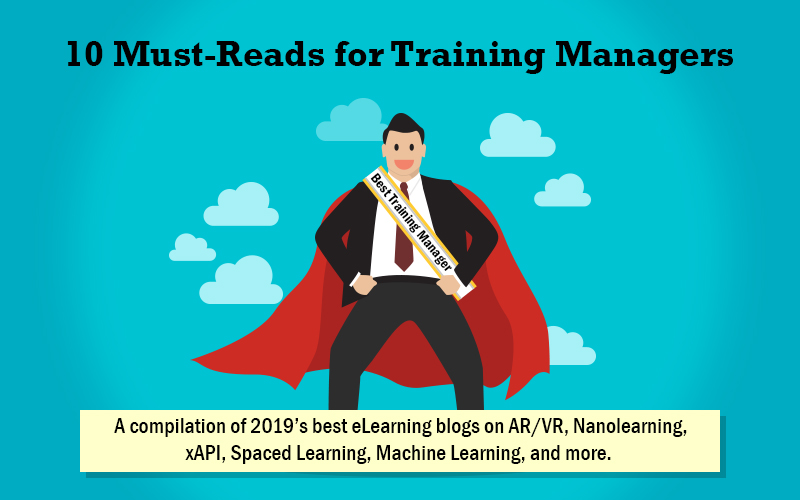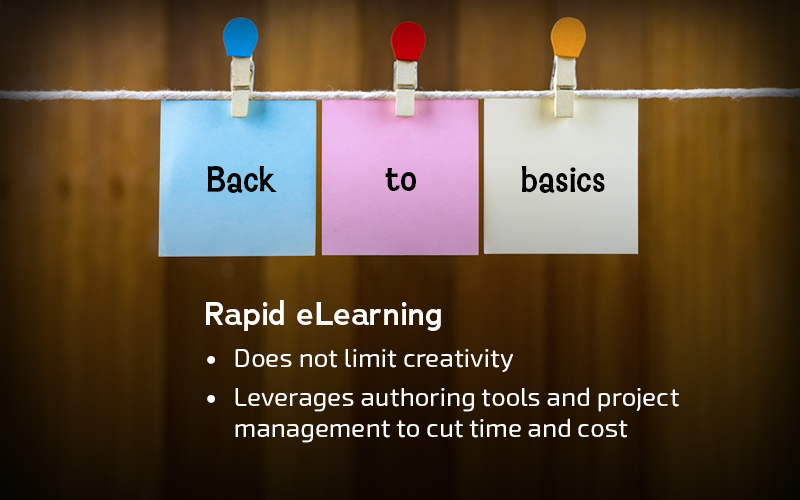Bid Goodbye to 2019 with these 10 Must-Read eLearning Blogs

“Oh! I can’t believe 2019 is almost over. Where did the days fly by!?” Yeah… that’s one extremely relatable reaction. As the end of year approaches, your life is going to be a whirlwind of lists, shopping, gifts, wishes, baking, and more! Yes lists! There are so many – gifts list, resolutions list, songs list, most influential persons list, best jokes list…you get the idea. And to add to those, we have one of our own – a list of 10 must-read eLearning blogs. (*sheepish smile*)
Download this handy guide on using eLearning to achieve business goals.
“Oh no, not another list!”
Okay, I totally understand! But here’s the thing. This list will give you a bird’s eye view of all the eLearning trends and practices that had L&D buzzing this year – and you’ll need that list to know what to focus in 2020. So, hold on to your party hats while we take you through the online training trends that have taken L&D by storm.
10 Must-Read eLearning Blogs of 2019
1. How do you Train Millennials?
Millennials make up 35% of the workforce today and this is just the start. Not only are they going to form a majority at the workforce, they’re also going to be among the ones that display excellent potential. And they’re here to stay.
You, of course, want to know how to manage them in the workplace – and how to keep them engaged. To achieve this, you need to understand them, know what drives them, and what they desire.
Millennials are a ‘post-globalization’ generation who like instant and easy solutions and access to information. They too, like almost everyone else, value meaningful work, freedom, recognition, and opportunities to grow. They are more likely to stay at a job they love doing and have fun while working.
This is why edutaining them is so important. Want to know how? Here is a blog to show how edutainment has become integral to millennial eLearning.
2. Microlearning or Nanolearning? “Wait…. Aren’t they the Same?”
Does this sound familiar? Your employees putting-off training or are reluctant to go through with it because of urgent work commitments…the main reason being the length and duration of the training? The obvious solution is to downsize eLearning courses to shorter microlearning modules, isn’t it?
What! You’ve already done that but still find few takers for training? Even now the course completion rate is adequate at best? Well, in this age of instant gratification, can you offer them ‘2-minute learning’ like 2-minute noodles?
Seems you can! With a new learning methodology – Nanolearning. It is all about 2-3 minute modules that provide short and precise information without compromising on training quality.
To get the best results, you need to understand where nanolearning will fit best in your online learning program. Know about nanolearning and its role in employee training in this blog.
3. “What do You do with xAPI in eLearning?”
If you are familiar with terms such as AICC, SCORM, and cmi5, you might want to read this blog. As you know, xAPI is one of the recent eLearning technical standards developed to fill the gaps in tracking learning activities through SCORM.
However, for all its merits and benefits such as tracking of offline mobile learning experiences, xAPI has not been widely accepted by most organizations. This blog on different ways xAPI can be used in eLearning will help you improve your online training.
4. AR and VR in eLearning – How Far and How Real?
Have you watched the latest Avengers movie? That indescribable feeling of being in the eye of a storm or in the middle of a fight sequence with bullets flying around? Can you imagine what would happen if your eLearning courses were the same?
Virtual reality and augmented reality (VR/AR) have already entered L&D and are becoming one of most sought-after eLearning trends. But how effective are they in corporate training? Are they really worth the training dollars spent on them?
Make an informed decision after reading this blog on the relevance of AR and VR in online training today.
5. Learning Experience Platform – Why is the LMS Sometimes Not Enough?
Do your learners groan at the very mention of the LMS? That is completely understandable, especially if your LMS is tech-heavy. Until a few years ago, LMSs were programmed like software applications, making them very cumbersome to be used by regular users, facilitators, and instructors The excruciatingly slow page function that goes on loading… loading… loading… can lead to some serious self-inflicted head trauma.
While discussions on eLearning always talk about it being learner-centric, when it comes to the LMS, oftentimes the opposite is true. As Josh Bersin says, “LMS systems were never designed to be employee-centric. They were developed as ‘Management’ systems for learning, focused on business rules, compliance, and catalog management for courses.”
A Learning Experience Platform (LEP) on the other hand gives the look and feel of Netflix and Spotify, making it very much more appealing to learners. It is designed with a learner-centric approach by focusing on providing an experiential learning journey.
It’s time to move beyond the traditional LMS functions and look for a learning platform which facilitates managing all new and improved learning technologies and trends. Read this blog to know how LEP fares in this regard.
6. Why Should Learning be Spaced?
Do you love pie? Of course, you do. Everyone loves pie. Let’s say I serve you an entire pie at a meal…and as soon as you’re done, I serve you another…and another, and…you get the idea. Would you still love it? Wouldn’t you want to shove the next one on my face?
The same is true for training. Training, like that warm apple pie is more enjoyable and effective when served at intervals. However interesting and engaging the training program may be, a whole lot of it at one time may prove to be too much of a good thing, and may not make any difference in terms of improving the learner’s skill and productivity.
Effective long-term learning is rarely achieved by a one-off event and that is why you should give learners some space for reflection. It will enhance knowledge retention in learners and beat the forgetting curve. Don’t take our word for it; read this blog and you’ll understand the value of spaced learning.
7. Which Level of Interactivity Fits Your eLearning Courses?
When people talk about interactivities in an eLearning course, they don’t always mean the same thing. An interactive course may mean a ‘click-next’ course or one with advanced simulation. While most PowerPoint to eLearning conversions are low on the interactivity ladder, with simulations higher up, it doesn’t really mean one is better than the other.
How interactive a course should be depends on the content and training requirement. Software training aims to provide practical knowledge on operating the software and a click-next approach for this will be absolutely useless. Similarly, compliance courses on standards and regulations meant to impart information, and designing a highly interactive course will be completely unnecessary as well as expensive.
Want to know which level of interactivity is best suited for your training design? Why don’t you start with this blog to get a detailed understanding of when and how different levels of interactivity are used?
8. What Should You Focus on to Make eLearning Adaptive?
‘Put yourself in their shoes’ is a frequently used phrase that is easier said than done. While most people in L&D strive to fulfill their duty to learners, it is not always possible to give them a fully-personalized learning experience. This is where Adaptive Learning comes in as a game changer.
Adaptive learning is all about tailoring the learning experience to fit the learner’s training need in real time. And it derives its power from 5Cs – Clarity on learning objectives, Curating content from existing resources, Chunking content for prescriptive learning, Creativity in instructional activities, and Creating different learning experiences for the same objective.
Learn about these 5 design principles and their role in adaptive learning design in this blog.
9. What is Situated Cognition and How is it Implemented?
When do you determine the success of a training program? Surely not when learners finish taking it. Even high scores do not mean better application and productivity.
It’s only when learners are able to use the knowledge gained in training and apply it to their jobs can you conclude the training program was a success. That is why providing proper context and real-world examples is critical when designing eLearning programs.
Situated cognition helps in building this real-world context for learners. Here’s a blog to help you understand situated cognition and how it works in eLearning design.
10. Machine Learning in eLearning – How does the Future Look?
They say the only limit to Artificial Intelligence is human imagination. With the world becoming more and more automated, it is not surprising that AI has ventured into the realm of L&D too.
Machine learning, a subset of AI, uses algorithms and statistics to determine patterns and inference from users’ computing and web activities. Can you imagine how sleek corporate eLearning will become when machine learning is used to build the learning journey?
Keep the technical jargon aside and read this award-winning article on how machine learning works in the context of online employee training.
Summing it Up!
Now that we have reached the end this list, as well as this year; let me ask you something.
- Do you want your business productivity to reach new heights next year?
- Do you want your employees to become more skillful, productive, and proactive in their jobs?
- Do you want your employees to think you’re the world’s best training manager?
If you’ve answered “yes” to any of these questions, then this list of the Best eLearning Blogs of 2019 is tailor made for you. Start scrolling down these blogs without delay.
And if you are running to earn the title of ‘Best Training Manager of the Year’, here’s an additional gift – an eBook especially made to guide you on the journey of rapid eLearning. Now you can master both time and efficiency in employee training design.





